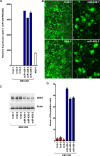Differential expression of the miR-200 family microRNAs in epithelial and B cells and regulation of Epstein-Barr virus reactivation by the miR-200 family member miR-429
- PMID: 20484493
- PMCID: PMC2897641
- DOI: 10.1128/JVI.00379-10
Differential expression of the miR-200 family microRNAs in epithelial and B cells and regulation of Epstein-Barr virus reactivation by the miR-200 family member miR-429
Abstract
The miR-200 microRNA family is important for maintaining the epithelial phenotype, partially through suppressing ZEB1 and ZEB2. Since ZEB1 inhibits Epstein-Barr virus (EBV) reactivation, we hypothesized that expression of miR-200 family members in epithelial cells may partly account for higher levels of EBV reactivation in this tissue (relative to nonplasma B cells). Here we show that, whereas miR-200 family members are expressed in epithelial cells, their expression is low in latently infected B cells. Furthermore, the miR-200 family member miR-429 shows elevated expression in plasma cell lines and is induced by B-cell-receptor activation in Akata cells. Lastly, expression of miR-429 can break latency.
Figures




Similar articles
-
Secreted Oral Epithelial Cell Membrane Vesicles Induce Epstein-Barr Virus Reactivation in Latently Infected B Cells.J Virol. 2016 Jan 13;90(7):3469-79. doi: 10.1128/JVI.02830-15. J Virol. 2016. PMID: 26764001 Free PMC article.
-
Cellular differentiation regulator BLIMP1 induces Epstein-Barr virus lytic reactivation in epithelial and B cells by activating transcription from both the R and Z promoters.J Virol. 2015 Feb;89(3):1731-43. doi: 10.1128/JVI.02781-14. Epub 2014 Nov 19. J Virol. 2015. PMID: 25410866 Free PMC article.
-
MicroRNA miR-155 inhibits bone morphogenetic protein (BMP) signaling and BMP-mediated Epstein-Barr virus reactivation.J Virol. 2010 Jul;84(13):6318-27. doi: 10.1128/JVI.00635-10. Epub 2010 Apr 28. J Virol. 2010. PMID: 20427544 Free PMC article.
-
Epstein-Barr virus latency: LMP2, a regulator or means for Epstein-Barr virus persistence?Adv Cancer Res. 2000;79:175-200. doi: 10.1016/s0065-230x(00)79006-3. Adv Cancer Res. 2000. PMID: 10818681 Review.
-
[The entry of Epstein-Barr virus into B lymphocytes and epithelial cells during infection].Bing Du Xue Bao. 2014 Jul;30(4):476-82. Bing Du Xue Bao. 2014. PMID: 25272606 Review. Chinese.
Cited by
-
B Cell Receptor-Responsive miR-141 Enhances Epstein-Barr Virus Lytic Cycle via FOXO3 Inhibition.mSphere. 2021 Apr 14;6(2):e00093-21. doi: 10.1128/mSphere.00093-21. mSphere. 2021. PMID: 33853871 Free PMC article.
-
The Role of microRNAs in the Pathogenesis of Herpesvirus Infection.Viruses. 2016 Jun 2;8(6):156. doi: 10.3390/v8060156. Viruses. 2016. PMID: 27271654 Free PMC article. Review.
-
miRNAs in the pathogenesis of oncogenic human viruses.Cancer Lett. 2011 Jun 28;305(2):186-99. doi: 10.1016/j.canlet.2010.08.018. Epub 2010 Oct 12. Cancer Lett. 2011. PMID: 20943311 Free PMC article. Review.
-
MicroRNA Regulation of Human Herpesvirus Latency.Viruses. 2022 Jun 2;14(6):1215. doi: 10.3390/v14061215. Viruses. 2022. PMID: 35746686 Free PMC article. Review.
-
Interpretation of EBV infection in pan-cancer genome considering viral life cycle: LiEB (Life cycle of Epstein-Barr virus).Sci Rep. 2019 Mar 5;9(1):3465. doi: 10.1038/s41598-019-39706-0. Sci Rep. 2019. PMID: 30837539 Free PMC article.
References
-
- Bracken, C. P., P. A. Gregory, N. Kolesnikoff, A. G. Bert, J. Wang, M. F. Shannon, and G. J. Goodall. 2008. A double-negative feedback loop between ZEB1-SIP1 and the microRNA-200 family regulates epithelial-mesenchymal transition. Cancer Res. 68:7846-7854. - PubMed
-
- Cullen, B. R. 2006. Viruses and microRNAs. Nat. Genet. 38(Suppl.):S25-S30. - PubMed
Publication types
MeSH terms
Substances
Grants and funding
LinkOut - more resources
Full Text Sources
Other Literature Sources
Research Materials

